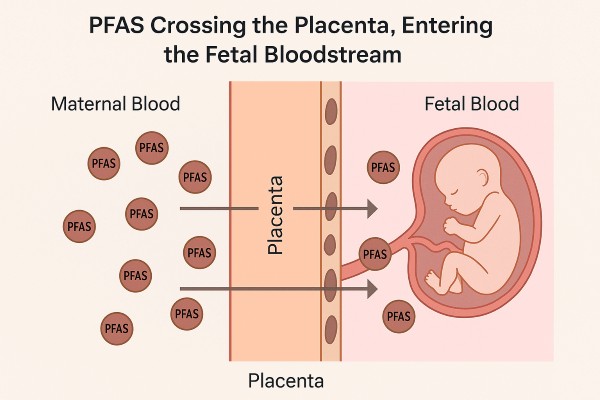Introduction
Imagine pouring yourself a cool and refreshing glass of water. It’s something we do every day, often without thinking. But if you’re pregnant or planning to become pregnant, what’s in that water could matter more than you realize. Increasingly, scientists are raising red flags about a group of man-made chemicals called PFAS and their potential effects on pregnancy, fetal development, and long-term child health. These chemicals are present in drinking water across the U.S.
You may have heard PFAS referred to as “forever chemicals” in the news, or seen headlines linking them to cancer or immune system problems. But what’s especially concerning is how these substances affect pregnant women and developing babies. Research has connected PFAS to serious complications like preeclampsia, low birth weight, miscarriage, and disrupted hormonal development in utero.
This article explores what PFAS are, how they’re affecting American families, and what you can do to protect yourself and your baby.
Background on PFAS and Pregnancy
PFAS (Per- and Polyfluoroalkyl Substances) are a class of more than 12,000 synthetic chemicals used since the 1940s. They resist heat, water, and oil, which has made them popular in a wide range of everyday products, including:
- Non-stick cookware (like Teflon™ pans)
- Microwave popcorn bags and fast-food wrappers
- Water-resistant clothing (such as rain jackets)
- Carpets and upholstery
- Firefighting foam (in AFFF formulations used on military bases and airports)
Over decades of use and because PFAS don’t easily break down, they build up in the environment and in our bodies over time. Today, PFAS contamination has been found in all 50 states, particularly in water supplies near industrial sites, military bases, airports, and landfills.
How Do PFAS Enter Our Bodies?
PFAS exposure is nearly impossible to avoid entirely. The most common ways Americans are exposed include:
- Drinking contaminated tap water
- Eating food from PFAS-coated packaging
- Using personal care products containing PFAS
- Living near manufacturing plants, airports, or military bases
- Inhaling indoor dust or using stain-resistant furniture and carpets
Studies have shown that over 97% of Americans have detectable levels of PFAS in their blood. Pregnant women, who already experience increased water intake and physiological changes, may absorb and retain these chemicals at even higher levels.
Why Pregnancy Is a Critical Window
Pregnancy is one of the most biologically sensitive times in a person’s life. During these months, hormones and organs must work in precise balance to support both the mother and developing fetus. PFAS can disrupt this process in multiple ways.
Most critically, PFAS can cross the placenta, entering the fetal bloodstream. This means that even low levels of PFAS in a mother’s blood can be transmitted to her baby, potentially interfering with development in the womb and increasing health risks later in life.

How PFAS Impact Pregnancy
1. Hormonal Disruption
PFAS are known endocrine-disrupting chemicals (EDCs). They can interfere with estrogen, progesterone, and thyroid hormones which are all essential for maintaining a healthy pregnancy. This disruption can affect placental development, nutrient transport, and fetal brain growth.
2. Placental Impairment
PFAS accumulate in the placenta, potentially reducing its ability to nourish the fetus. A compromised placenta can lead to poor fetal growth, higher risk of preterm delivery, and complications like preeclampsia. Mothers are especially at risk for preeclampsia because an impairment in the arteries of the placenta lead to hypertension and pathological sequelae.
3. Pregnancy Complications
Certain PFAS, especially in prolonged, high concentrations may increase the chances of causing serious pregnancy complications like preeclampsia, low birth weight, miscarriage, and pre-term labor.
Preeclampsia
Preeclampsia is a serious pregnancy complication marked by high blood pressure, protein in the urine, and signs of damage to organs such as the liver or kidneys. Recent studies suggest that exposure to certain PFAS chemicals during pregnancy may increase the risk of developing preeclampsia.

For example, the LIFECODES birth cohort study found that higher maternal levels of PFOS and PFDA were associated with a 60% and 64% increased odds, respectively, of late-onset preeclampsia.
Similarly, the Canadian MIREC study found that women with the highest PFHxS levels had more than three times the odds of developing preeclampsia compared to those with the lowest exposure.
These findings suggest that PFAS may contribute to inflammation, oxidative stress, and abnormal blood vessel development in the placenta—all of which are implicated in the onset of preeclampsia. While more research is needed to confirm causal relationships, the evidence points to a concerning association that warrants further attention and public health action.
Low Birth Weight
Recent U.S.-based research indicates that prenatal exposure to PFAS may contribute to reduced fetal growth and lower birth weights. This is especially concerning because babies born with low birth weight (under 5.5 pounds) are at increased risk for infections, developmental delays, and chronic health issues.
A 2023 study funded by the National Institutes of Health’s Environmental influences on Child Health Outcomes (ECHO) program analyzed data from over 3,000 pregnant women across 11 cohorts. The researchers found that mothers with higher PFAS levels in their blood were more likely to deliver babies with low birth weight compared to those with lower PFAS levels.
These findings underscore the potential impact of environmental contaminants like PFAS on fetal development, highlighting the importance of monitoring and regulating these substances to protect maternal and child health.
Miscarriage and Preterm Labor
Additionally, emerging research indicates that prenatal exposure to PFAS may also be linked to an increased risk of miscarriage and preterm birth. While the exact biological mechanisms remain under investigation, hormonal disruption and immune system effects are suspected contributors.
A study from the Swedish SELMA cohort found that higher maternal serum levels of perfluorooctanoic acid (PFOA) in early pregnancy were associated with an increased risk of sporadic first-trimester miscarriage. Specifically, a doubling of PFOA exposure corresponded to a 50% higher risk of miscarriage during the second half of the first trimester.
Research has also explored the relationship between PFAS exposure and preterm birth. A study published in Environmental Research indicated that exposure to PFOS, PFOA, and PFNA during pregnancy might be associated with an increased risk of preterm birth.

Long-Term Effects on Children Exposed to PFAS in Utero
The story doesn’t end at birth. Prenatal PFAS exposure has been linked to:
- Delayed cognitive development and lower IQ
- Behavioral disorders, including ADHD and anxiety
- Increased risk of obesity and metabolic issues
- Altered immune responses, such as reduced vaccine effectiveness
- Hormonal imbalances during puberty
A landmark study conducted in Ohio and West Virginia known as the C8 Health Project found clear associations between prenatal PFAS exposure and developmental delays, asthma, and weakened immune systems in children.
Scientists are still studying these outcomes, but the EPA and CDC have officially recognized that certain PFAS can cause developmental effects in children and elevated risks in pregnancy.
What About Breastfeeding?
Yes, PFAS can even be found in breast milk. However, leading organizations like the Centers for Disease Control and Prevention (CDC) and the American Academy of Pediatrics still recommend breastfeeding. The benefits of breast milk which include nutrition, immune support, and bonding typically outweigh the risks from PFAS exposure, especially if other sources of exposure are minimized.
For women who are currently pregnant or planning to become pregnant and have a history of PFAS exposure (for example, living near a military base or working as a firefighter), healthcare providers often recommend additional monitoring. While simply having PFAS in your blood doesn’t mean an illness will occur, knowing the potential risks empowers pregnant individuals to take precautions.
What You Can Do to Protect Yourself and Your Baby
PFAS are pervasive and nearly impossible to eliminate completely, but that doesn’t mean you’re powerless. Here are effective steps to reduce your exposure, especially during pregnancy:
Filter Your Drinking Water
If you’re in a known PFAS-affected area (check the EPA’s PFAS Interactive Map), consider installing a reverse osmosis or activated carbon filter certified to remove PFAS. Brands with NSF/ANSI 53 or 58 certification are ideal.
Avoid PFAS-Containing Products
- Ditch non-stick cookware for cast iron or stainless steel
- Skip “stain-resistant” sprays or fabrics
- Check personal care items for ingredients like PTFE, perfluoro-, or fluoro-
- Opt for PFAS-free makeup, sunscreen, and lotions when possible
Limit Fast Food and Packaged Meals
PFAS often leach into food from grease-resistant packaging. Cooking at home with fresh ingredients significantly reduces exposure. Alternatively, search for packaged meals that come in glass jars or other PFAS-free containers.
Be Informed About Local Water Quality
Visit your city or state’s environmental health department website to find PFAS testing data. You can also request a Consumer Confidence Report (CCR) from your local water supplier.
Talk to Your Doctor
If you’re concerned about PFAS exposure due to your location, occupation, or product use, speak to your OB-GYN or a maternal-fetal medicine specialist. Blood testing for PFAS is available through some health departments and environmental clinics.
What’s Being Done Across the Country?
In light of the PFAS contamination crisis, there has been significant action at federal and state levels to address contamination from AFFF and other sources – though the aggressiveness of these actions has varied by administration.
Going into April 2025, the regulatory landscape is a mixed picture.
Progress is being made – the U.S. military will soon eliminate AFFF, many states have banned non-essential PFAS uses, and public awareness is at an all-time high.
Yet, challenges remain, especially with potential federal rollbacks.
Expected Challenges to PFAS Regulation
- State Level: Stakeholders (from environmental groups to state attorneys general) are poised to fight any federal attempts to strip away state rights to regulate PFAS. If the current Trump administration proceeds with preemption of state chemical bans, it is expected to face legal battles, as states defend their authority to protect citizens from “forever chemicals.”
- Federal Level: On the federal level, we may see renewed efforts in Congress to pass comprehensive PFAS legislation (for example, to set a national drinking water standard by law or to fund cleanup).
In summary, across the country there is considerable action on PFAS. The coming year will be crucial in determining whether the U.S. establishes a uniform, stringent approach to regulating PFAS, or whether state-level innovation continues to drive the response.
Grassroots Efforts
For concerned citizens, this means staying informed on both federal policy changes and your own state’s regulations. Get involved and let your representatives know that PFAS contamination is an important issue to you.
Encouragingly, the issue of PFAS contamination is now widely recognized, and no matter the administration, there is pressure on officials to respond to what has been called a public health crisis.
The hope is that through a combination of state leadership, federal standards, and accountability via lawsuits (like the AFFF lawsuit), PFAS pollution will be curbed and communities – including vulnerable groups like pregnant mothers and infants – will be better protected in the near future.
PFAS-related Pregnancy Harm and the AFFF Lawsuit
Currently, there are several ongoing, active lawsuits surrounding AFFF water contamination. One of those lawsuits is a multi-district litigation (MDL) that is focused on personal injury cases (claims by individuals suffering health problems from PFAS exposure through AFFF).
While pregnancy complications like high blood pressure disorders are scientifically linked to PFAS, by themselves they have not yet been the primary injury accepted in these lawsuits. If a claim already includes one of the currently accepted conditions, then pregnancy complications may be considered in addition to the overall claim.
If you are in the high-risk population for PFAS exposure through drinking AFFF contaminated water and had pregnancy complications, it’s still worth consulting a lawyer. That’s because the science is still evolving and the scope of injuries in this lawsuit may expand to include pregnancy complications as a standalone claim in the near future.
Pregnancy and PFAS Lawsuit FAQs
A Final Word for Expecting Parents
Being pregnant can feel like an emotional whirlwind which ranges from excitement, joy, and yes, can sometimes be overwhelming. The thought of invisible chemicals affecting your baby can be frightening. But remember: knowledge is a form of protection.
By becoming informed and taking small steps, you’re already doing something powerful. You’re not only protecting yourself, you’re building a safer future for your child.
You don’t need to eliminate every exposure to stay healthy. What matters is awareness, intention, and support. Ask questions, choose safer products, filter your water, and lean on your healthcare team.
Your baby’s journey begins with your choices and every mindful step you take is a loving act of care.
Written By:

Dr. Annas Ghafoor
Medical Contributor
Dr. Ghafoor is an author and medical reviewer at PFAS Water Experts. He is currently a neurology resident physician at Michigan State University and has managed a wide range of neurological cases that stem from environmental toxicology issues – both in the adult and pediatric populations.
LEGAL REVIEW BY:

Andrew J. Cobos
Lawyer and Legal Reviewer
Andrew J. Cobos serves as the Chief Veteran Legal Counsel at PFAS Water Experts. As a veteran lawyer, he represents military veterans impacted by AFFF water contamination on military bases in ongoing PFAS mass tort litigation. As a U.S. Military Academy graduate (2003) and combat veteran, he has a deep passion for helping those who have served our country get the compensation they deserve for complex injury cases.






